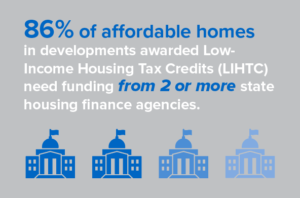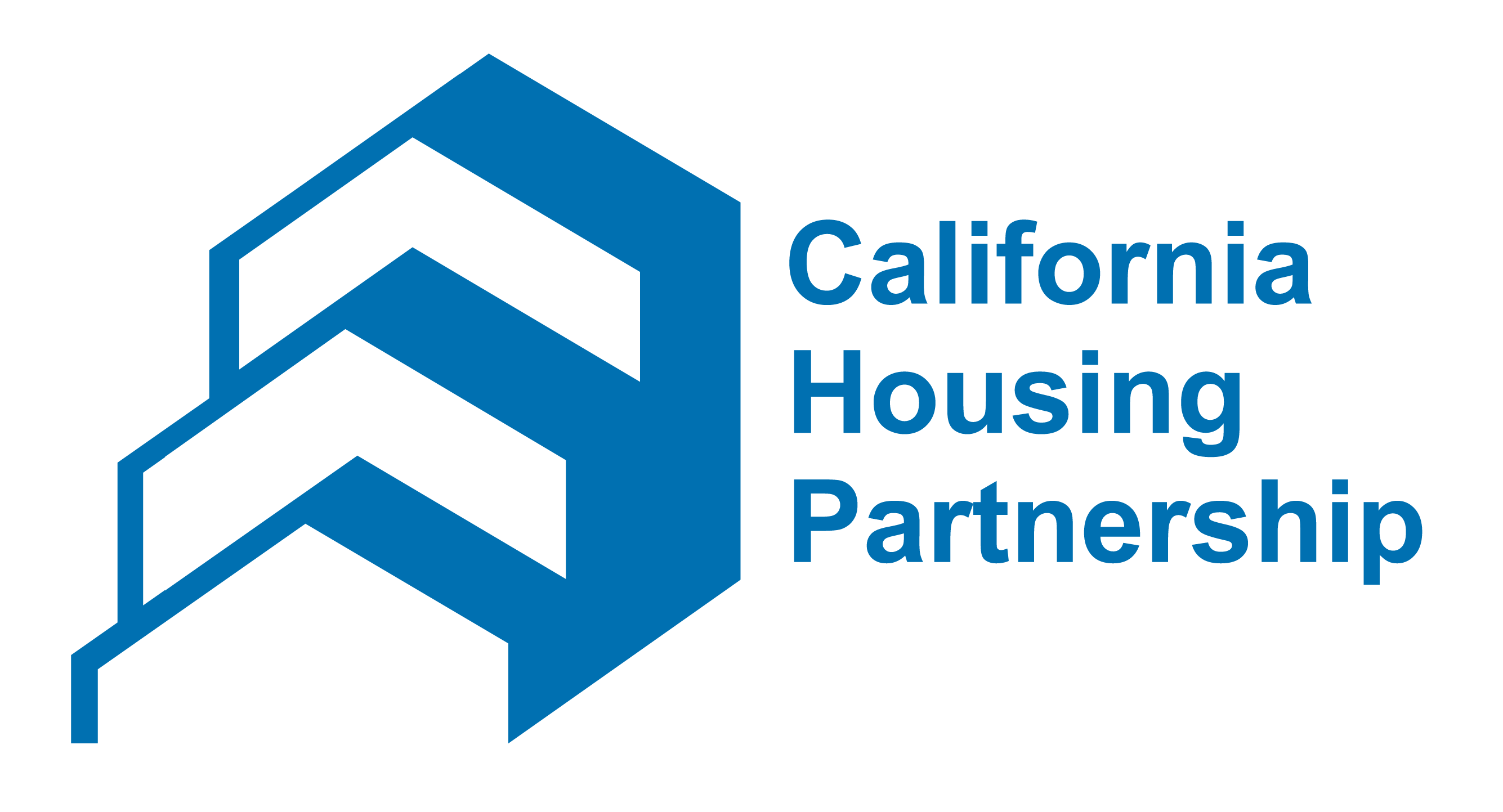A SYSTEMS ISSUE WITH A HEAVY PRICE TAG (WHITE PAPER)
Numerous policymakers have cited the pressing need to reduce the cost and time involved in producing new affordable rental homes in California; as have taxpayers, the media, and stakeholder groups taking a critical look at accountability in this realm. New analysis from the California Housing Partnership (the Partnership) finds that each additional state funding entity involved in the financing of an affordable rental housing development is associated with an increase of $15,800 per unit in total development costs (TDC) on average. This includes housing agencies that fall within the Treasurer’s office (CDLAC, TCAC) or under the Governor’s leadership (HCD, CalHFA and SGC).
 A majority of affordable housing developments in California could realize these estimated cost savings – 86 percent of affordable homes in developments awarded Low Income Housing Tax Credits (LIHTCs) needed funding from two or more state housing finance agencies. Given that affordable housing rental developments typically require funding from two to four state funding agencies, the potential savings of effectively reducing these into a singular body could be as much as $47,400 per door.
A majority of affordable housing developments in California could realize these estimated cost savings – 86 percent of affordable homes in developments awarded Low Income Housing Tax Credits (LIHTCs) needed funding from two or more state housing finance agencies. Given that affordable housing rental developments typically require funding from two to four state funding agencies, the potential savings of effectively reducing these into a singular body could be as much as $47,400 per door. The current system is fractured in a way that requires developers to apply for funding through multiple competitions under the differing rules and priorities of each agency and its governing bodies, adding time and cost over several years. The State Controller[1], the State Auditor[2] and the Governor[3] have all concluded that there is an urgent need to streamline state housing funding agencies.
The Partnership is very thankful that AB 434 (Daly) was signed into law in 2020. It is a significant step in the right direction, aligning seven rental housing programs at HCD. Simultaneously, as work is executed to implement that bill, it is time for the state and the affordable housing community to pursue the adjacent initiative of creating a unified award process for the state’s five housing agencies as they distribute resources to upcoming developments.
ENVISIONING A PROVERBIAL ONE-STOP SHOP
One option that has been under discussion for decades is to merge the five agencies. Governors Schwarzenegger and Brown each spent several years searching for ways to do this effectively, but due to logistical and operational obstacles arising from the management of the agencies being under two different state constitutional offices, this was unachieveable in their tenures.
Today, the Partnership is working with officials from these offices to explore the possibility of achieving similar results through a memorandum of understanding that would enable the state housing agencies to award their affordable rental housing funds through a single process, the proverbial “one-stop shop.” This is not unprecedented – other states, such as Minnesota, have consolidated programs into a unified award process in recent years. It is within reach in California to enact a single-application process for state affordable rental housing resources, with one rating and ranking system and designated set-asides by housing type or other project characteristics as desired.
The state can do this in a simplified manner by instituting a coordinated “Affordable Housing Finance Committee” consisting of representatives from each state housing funding agency. (The Partnership recommends altering the existing TCAC committee to serve this purpose as it already has affected entities as voting members.)
This body would operate as follows:
- The Committee: Will jointly set the rules for rating and ranking development applications.
- The Committee: Will offer all state rental housing resources, including tax credits, bonds, and soft loans, at the same time under a single application.
- The housing agencies: Will have trained staff to process the single application and to review it by the single standard.
– Applications will be distributed among all participating staff, with managers from the five agencies ensuring consistency of work product.
– For applications requesting HCD-managed resources, HCD staff will be given lead reviewing responsibility. - Developers: In filling out applications, will indicate whether they need 9% credits or 4% credits with bonds, or if they can accept either.
– If either, they will rank their preference and provide two Sources and Uses proposals to reflect the differing gap needs and differing costs. - Developers: Will also rank-order the gap funding sources they are able to accept, establishing eligibility for each based on key threshold qualifications.
- The state: Will rank all applications and establish a funding order, then begin processing the list to award each applicant’s primary choice of funding, as available, or second or third choice, if not.
- The state: Will continue to process through the list of applications until all resources are awarded, postponing or rejecting projects which cannot be fully funded within the resources available.
This process eliminates the overlapping reviews conducted by each state agency independently, and it effectively enables the resources to follow the developments rather than the developments chasing the resources, as they do in the current system. Authorized uses of the Governor’s proposed $2 million budget appropriation for AB 434 implementation could be broadened to engage a professional third-party management consultant to advise and project manage development of this concept and its subsequent implementation, to see this streamlining initiative to fruition.
CALLING ON THE GOVERNOR AND TREASURER TO ACT
Ultimately, a one-stop shop would result in top-ranking developments receiving all needed state funding at once through the single-application system, letting them start construction punctually and avoiding successive time-consuming application rounds that put their other funding commitments at risk.
At the same time, costs are reduced significantly for both the state and for mission-driven housing providers, making the best use of limited resources to move rent-burdened, overcrowded and unhoused Californians into affordable rental homes as quickly and effectively as we can.
_
For further discussion, please contact our Director of Legislative & Regulatory Advocacy.
APPENDIX A: DETAILED METHODOLOGY AND SOURCES
To estimate potential cost savings of consolidating the award of state funding, we use a multivariate regression model to estimate the effect of multiple funding sources and agencies on total development costs, controlling for differences in project characteristics. For the model, we use development cost data for properties receiving Low Income Housing Tax Credits (LIHTC) from 2012-2019. This data comes from sources and uses information included in LIHTC applications submitted to the California Tax Credit Allocation Committee (TCAC) and reflects the developer’s best estimates of project costs at the time of application.
We identify the number of distinct state entities (TCAC, CDLAC, HCD, SGC, and CalHFA) financing each development with tax credits, bonds, and soft loans. Then, we estimate the impact of each additional source / entity on total development costs using the regression model described above.
For more information about this analysis, please Contact Us (Research or Legislative Advocacy).
[1] A Single Agency to Streamline the State’s Housing Programs, State Controller Betty Yee
[2] California’s Housing Agencies, Auditor of the State of California
[3] Governor’s Budget Summary 2021-22, California Department of Finance, p. 128
